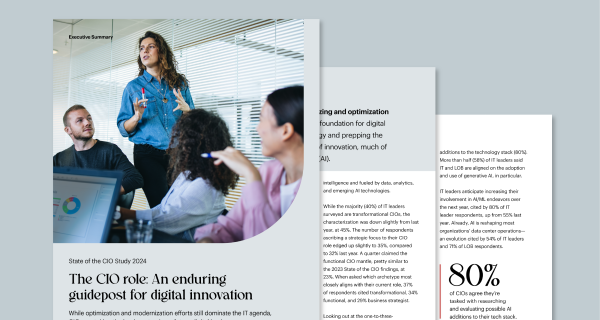The 21st annual State of the CIO research is here, and this year’s edition reveals the technology and business initiatives IT leaders have for their organizations in 2022 and beyond. Other areas covered include the impact of the pandemic on the IT organization, reporting structure, IT budgets, hiring and retaining skills, and much more.
To highlight the research through CIO discussions, the Foundry team partnered with the CIO Executive Council on a webcast. Hosted by Tim Scannell, Vice President of Strategic Content at the CIO Executive Council, moderated by John Gallant, Enterprise Consulting Director, CIO and joined by two leaders in IT, Bess Healy, SVP and Chief Information Officer at Synchrony and Matt Lasmanis, Chief Technology and Innovation Officer at Sage Therapeutics, this webcast offers their first-hand perspectives as it relates to the results of the State of the CIO survey.
The many hats worn by the CIO
Today, IT leaders can hold many job titles – not just a chief information officer. Matt Lasmanis for example, said that his role encompasses what someone would classify as a chief data officer, chief analytics officer, digital officer, cybersecurity specialist, operations management, etc.
This is not surprising as the State of the CIO research uncovered that security management is a top priority for IT leaders in 2022. In fact, 51% of CIOs said they are currently focusing on security management, and 76% said they expect their involvement in cybersecurity to increase over the next year. Following this is data privacy/compliance (71%), and data analysis (58%). And just like Matt’s, 86% of CIOs also say that their role is becoming more digital and innovation focused.
“Not just one person makes a strategic difference. But when you bring all these roles together and you weave those capabilities into the strategy of the company, that’s when you’re really experiencing the value of the CIO”. – Matt Lasmanis, Chief Technology and Innovation Officer at Sage Therapeutics
Matt’s role proves that CIOs wear a lot of hats and are a relied upon role throughout the organization. Up from 28% in 2021, 58% of line of business respondents to the State of the CIO study characterize their CIO as a strategic advisor – someone who proactively identifies business needs/opportunities. Additionally, 21% view the CIO as a consultant, and only 8% view the CIO as a cautious voice of reason, which is down from 20% in 2021.
When asked about this question, Matt said that he believes the percentage growth comes from the change of the traditional view of the CIO as the risk assessor and the cautious voice to a more forward-leaning, innovative aspect of the role.
Bess Healey from Synchrony also made the point that the CIO can be viewed as multiple different people, and it is indeed evolving. She says that “we (CIOs) have to be careful not to be defined by our titles. We need to be what the business needs us to be, and sometimes that changes on any given day.”
The impact of the pandemic and the future of work
CIOs are still navigating the hybrid work environment as the pandemic remains prevalent two years later. This unpredictable climate has not been easy on IT leaders, which was noted in the research as 74% of CIOs say their role was elevated due to the pandemic and this visibility within the organization is expected to continue. Additionally, 73% of CIOs say that remote and hybrid work have increased the stress on IT support staff and services.
Commenting on the impact of the pandemic, Bess Healy said “the future of work is more about pivoting, and less about recovery. While technology is at the forefront of the business, so are the people. Employee support is just as important as tech.”
From the research, CIOs also noted their top technology priorities specifically focused on hybrid work. At the top is improve cybersecurity (46%), ensure they have the right collaboration platform for their organization (32%), and improve network reliability/performance (27%).
When asked how he ensures hybrid meetings run smoothly, Matt explained that Sage Therapeutics is using artificial intelligence-based video to enhance user experiences as well as a new tool that creates equitable, high collaboration among the organization.
For additional insight, watch the full webcast here. To learn more about how CIOs are spending their time and prioritizing certain initiatives, download the 2022 State of the CIO executive summary and the 2022 State of the CIO white paper.






